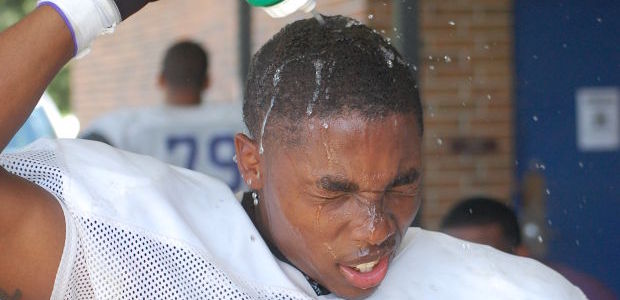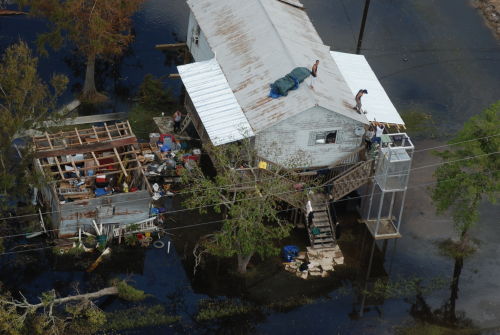
High School Sports: How safe is safe? Should more tests be required?
May 21, 2013
New hurdles to flood insurance
May 21, 2013The St. Mary Parish Cajun Coast Visitors Center is out of the swamp, resting securely on four times the amount of pilings that were originally holding it up.
Nearly structurally complete inside and out almost a year ago, “the belly” of the 1,400-ton Cajun Cabin Swamp attraction sunk a little more than 5 feet into the waist-deep swamp last June, days before it was set to open.
The $3.8 million, 16,000-square-foot facility was built on the other side of the levee, just off an elevated portion of U.S. Highway 90 at the Martin Luther King exit in Morgan City.
Expert House Movers completed its process to lift the center in just a little more than 100 days, Project Manager Bobby Fischer said.
“This building sank on its belly,” he said. “We had to take the smiley face out of it ,and it is now secure.”
The Cajun Coast Tourist Commission broke ground on the project in September 2010.
Washer Hill Lipscomb Cabanis Architects, of Baton Rouge, designed the project, which had been on the drawing board for more than 10 years, according to Cajun Coast Tourism Director Carrie Stansbury.
Russell Washer, viewing the building the day it sunk, called the event, “awful, and truly unexpected.”
The original contractor of the center was Laplace-based Aegis Construction Inc.
And, the original structural engineers on the project were Ragland, Aderman and Associates, of Baton Rouge. Neither would offer comment on the failure.
“It was an anomaly,” Stansbury previously said.
She said she had toured the building a week before, and everything had seemed. But days later, a painter working inside saw a crack in the sheet rock. Morgan City police officers said that when they arrived on the scene, you could still hear the building cracking and creaking.
Stansbury said many people have inquired “as to the cause of the failure and who was at fault. … Instead of going on that kind of path, we chose not to bring the matter to court.
“My board decided to focus on the solution to the problem. As a result of that path, we settled the case in a timely manner.”
Noting that the building was bonded and insured for $3.7 million, Stansbury said the board hired Gary McGoffin, of the firm Durio, McGoffin, Stagg and Ackermann, in Lafayette, to represent Cajun Coast in the unexpected dilemma.
“All parties that had been involved in building this project worked together very well, with solutions on how to resolve the problem instead of going through a long, drawn-out litigation process,” she said. “During the process, several ideas were brought forth as to the cause of the foundation failure and were discussed in mediation. This discussion was needed in order to resolve the foundation failure issue. However, all conversations in mediation are confidential. At the end of the day, all parties agreed the foundation could be safely repaired and the building could be salvaged. Nowhere in the settlement does it identify the cause or the fault.”
McGoffin said previously that he had held weekly meetings with Washer Hill and Ageis on ideas. “Frankly we still don’t know what happened,” he said. “One can say while looking at the structure, that it did not have enough pilings, yet we still don’t know if it’s a number, or a problem with the soil underneath.”
Nonetheless, with the settlement in hand, Stansbury said the board terminated its previous contracts.
The next step in fixing the center was to create a corporation called Cajun Coast Phoenix, which would oversee the project. Stansbury said all insurance monies were deposited into an account with this name.
Also, the tourist commission hired former City of Morgan City Chief Administrative Officer Lorrie Braus to manage the new company and represent the Cajun Coast as a third-party recipient.
Then, this past January, a $3.3 million contract was signed with Expert Home Movers, who began working immediately. Shortly after, EHM began selective demolition in January, with Fischer directing and Joe Matyiko, son of the company’s founder, making preparations.
“Not ever have I worked a job quite like this,” Matyiko said. “But I’ll say this – whoever put this baby together did a heck of a job, other than of course, the piles sinking.”
Neither Matyiko nor Fischer would comment as to their beliefs on why the building sunk.
“If this building had to fall, it fell perfect,” Fischer said. “All of the structural steel and rods that connected the slabs were run in the right direction. Conversely, if they were run in the opposite direction, the slab would have been blown apart,” he said.
Matyiko also commented that there were no structural cracks, not even cracks in the tiles in the bathrooms. “Before we walked in here, we expected a lot more damage to the building. We were very surprised at the condition it was in,” he said.
Fischer explained that his crew removed all of the sheetrock, due to mold concerns. Also, the elevator, a staircase and areas around a gas fireplace were dismantled.
“Only one section of the building, the front corner, took in a little water, maybe about four inches,” he said.
Using architectural plans, Fischer said he and Matyiko began preparations to drill the additional pilings, done using a combination of concrete cornering and slab sawing to cut 114 2-feet-by-6-feet holes around each of the 57 original pilings.
The original slabs were removed and then thrown into a dumpster. Then, they numbered each area and assigned a member of their crew to be a zone captain of that area.
“Once that was completed, we began drilling what we call our ‘Magnum Towers of Power’ – four steel push piers around each of the 57 pilings that were in place,” Fischer said.
Magnum steel push piers have been the product of choice for foundation repair, Fischer said.
According to magnum’s website at www.magnumpiering.com, with more than 30 tons of support capacity, the heavy-duty system is used across the country to lift and stabilize commercial and residential structures.
Matyiko said the piers were driven in 3-feet sections at a time and the building was used as a counterweight.
“As we pushed one piece, we add another section, and so on,” he said. “Little by little, 228 additional piers pilings were driven, to a depth of 95 to 100ft, encapsulating an original piling that was only driven to 50 feet,” Fischer said. “These were segmented structural pieces of pipe that were placed at each point in this building.”
“You could say that this building is now secure with a 4-to-1 safety factor,” Matyiko explained.
The next process was the lift.
“In essence, we now had 228 jacking points within the building,” Matykio said.
Fischer said his crew lifted the tourist center using a unified hydraulic system, unified jacks that sat on top of each of the steel push piers and lift frames.
“This was even slower than the drilling,” he said. “However, when we started the push using the unified jacks, when we pressurized up, we noticed that the pressures were not a working capacity pressure. After careful examination, we realized we had to cut away
the old piling systems to allow the building to come up.”
Braus said the original piles were friction piles, so the reason they had to be cut away from the building is that they wouldn’t lift because of the friction, or rather the pressure against the building. “So they had to cut the hold piles way from the pedestal, so that the rest of the building would lift,” she said.
Fischer said the building is now sitting on a gritted piling system, comprised of 4-and-a-half-inch magnum steel push piers. “This week, we will fill those piers with concrete grout, to secure them even further,” he said.
Fischer explained that if they had used what’s called common pressure to lift the building, it would have blown apart, because the heavier part would have come up first.
“Our plans are to have this project completed sometime before the end of summer to give summer visitors the opportunity to enjoy this facility,” Fischer said. “And be rest assured, when we’re finished, this building will be very safe for occupants for many years to come,” he said. “We are the turnkey in this project. The next phase is of course, the interior.”
Fischer said the company will also do a mold remediating test.
He is also planning to hire a roofer to remove one-third of the room, which has ripples in the roof line. All glass in the building is hurricane proof, he added. “Shortly, we will reseal all of the windows and spray-test them for leaks, in addition to reworking some frame work.”
Expert House Movers, or EHM, issued a one-year guarantee on its finished product to the tourist commission. However Fischer said magnum has a 30-year guarantee on its piling system. “We’ve had very little warranties to come back,” Fischer said.
EHM’s work has also been featured in National Geographic in print and on film. Their biggest project so far has been moving the 4,800-ton Cape Hatteras Lighthouse in North Carolina.
Matyiko estimates that since 1955, the family company has lifted 15,000 structures.
Just weeks before handing the St. Mary Tourist Commission the keys to its Welcome Center in Morgan City, architects and builders alike were shocked when the 1,400-ton facility slipped from its pilings and sank five feel below into the swamp. Expert House Movers raised the facility – anchoring it on four times as many pilings as the original plans called for – in a little more than 100 days.












